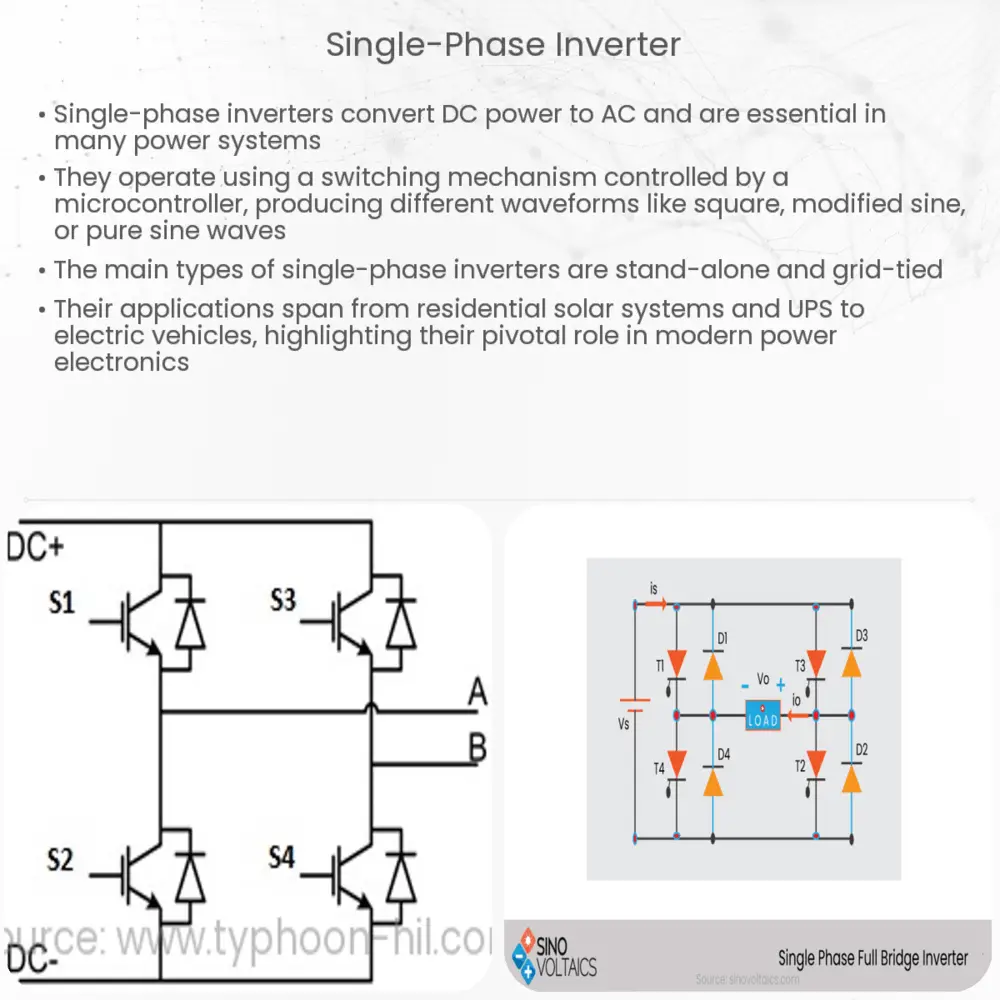Explore the workings of single-phase inverters, their types, key components, and diverse applications in power systems and electric vehicles.

Introduction to Single-Phase Inverters
In the world of power electronics, single-phase inverters hold a crucial position due to their widespread applications in numerous systems. An inverter is a device that converts direct current (DC) to alternating current (AC). While there are three-phase inverters designed for industrial applications, single-phase inverters are predominantly used for residential and small-scale commercial applications.
Working Principle of a Single-Phase Inverter
A single-phase inverter operates by converting a DC input, often sourced from a battery or a fuel cell, into an AC output. This is achieved through a process known as switching. The DC input is switched in a pattern that generates a pseudo-AC waveform, usually a square wave, modified sine wave, or pure sine wave.
The switching pattern is controlled by a microcontroller or a similar digital device, which ensures that the output is synchronized with the grid frequency and voltage if grid-tied operation is required. The result is an AC output that can be used to power standard household appliances that operate on AC power.
Types of Single-Phase Inverters
- Stand-alone inverters: These are independent systems that convert DC power stored in batteries into AC power. They are primarily used in off-grid systems, such as remote cabins, RVs, and boats.
- Grid-tied inverters: These inverters are designed to convert DC power into AC power that is synchronized with the grid. They are commonly used in residential solar photovoltaic systems.
Single-Phase Inverter Waveforms
The quality of the output AC from a single-phase inverter is determined by the type of waveform it generates. There are typically three types:
- Square wave inverters: These are the simplest type of inverter. They generate a crude approximation of an AC waveform, but can cause problems with sensitive electronics.
- Modified sine wave inverters: These generate a better approximation of a sine wave than a square wave inverter, but still fall short of a pure sine wave.
- Pure sine wave inverters: These generate an output waveform that is virtually identical to the sine wave shape of mains power. They are the most expensive, but also the best type of inverter for powering sensitive electronics.
Key Components of a Single-Phase Inverter
A typical single-phase inverter consists of several key components:
- DC source: This is the input to the inverter, typically a battery or solar panel.
- Inverter circuit: This circuit, usually composed of electronic switches such as transistors or thyristors, is responsible for converting the DC input into an AC output.
- Control unit: This component, often a microcontroller, controls the switching sequence of the inverter circuit to produce the desired AC output.
- Filter: An output filter is used to smooth out the inverter’s output waveform, especially for modified sine wave and pure sine wave inverters.
Applications of Single-Phase Inverters
Single-phase inverters have a broad range of applications in both residential and commercial settings. They are used in:
- Solar power systems: Single-phase inverters are commonly used in residential solar power systems to convert the DC output of solar panels into AC power that can be used in the home or fed back into the grid.
- Uninterruptible Power Supplies (UPS): In UPS systems, single-phase inverters convert the DC power stored in batteries into AC power to maintain a continuous supply of power during a power outage.
- Electric vehicles: Single-phase inverters are used in electric vehicles to convert the DC power stored in the battery into AC power to drive the electric motor.
Conclusion
In summary, single-phase inverters play an indispensable role in modern power systems. By converting DC power into usable AC power, they enable a multitude of applications, from residential solar power systems to electric vehicles. Their design, from the simplest square wave inverters to the more sophisticated pure sine wave inverters, reflects the diversity and complexity of power demands in today’s world. The study and understanding of single-phase inverters is therefore vital for anyone interested in the field of power electronics.

